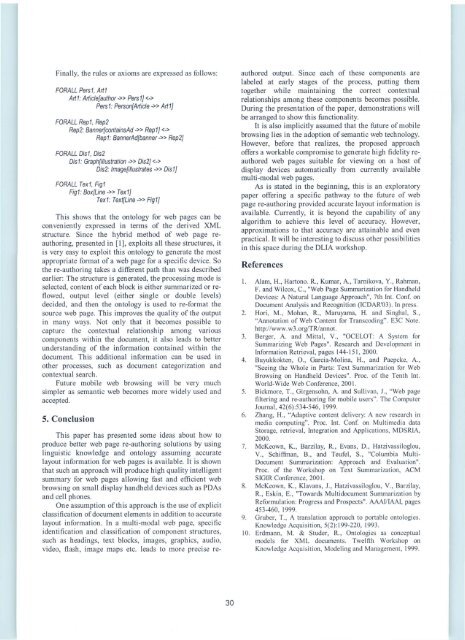RR_03_02
RR_03_02
RR_03_02
You also want an ePaper? Increase the reach of your titles
YUMPU automatically turns print PDFs into web optimized ePapers that Google loves.
Finally, the rules or axioms are expressed as follows:<br />
FORALL Pers1, Art1<br />
Art1: Article[author -» Pers 1J <br />
Pers1: Person[Article -» Art1J<br />
FORALL Rep1, Rep2<br />
Rep2: Banner[containsAd -» Rep1J <br />
Rep 1 : BannerAd[banner -» Rep2J<br />
FORALL Dis1, Dis2<br />
Dis1 : Graph[illustration -» Dis2J <br />
Dis2: Image[illustrates -» Dis1]<br />
FORALL Tex1, Fig1<br />
Fig1: Box[Line -» Tex1J<br />
Tex1: Text[Line -» Fig1J<br />
This shows that the ontology for web pages can be<br />
conveniently expressed in terms of the derived XML<br />
structure. Since the hybrid method of web page reauthoring,<br />
presented in [1], exploits all these structures, it<br />
is very easy to exploit this ontology to generate the most<br />
appropriate format of a web page for a specific device. So<br />
the re-authoring takes a different path than was described<br />
earlier: The structure is generated, the processing mode is<br />
selected, content of each block is either summarized or reflowed,<br />
output level (either single or double levels)<br />
decided, and then the ontology is used to re-format the<br />
source web page. This improves the quality of the output<br />
in many ways. Not only that it becomes possible to<br />
capture the contextual relationship among various<br />
components within the document, it also leads to better<br />
understanding of the information contained within the<br />
document. This additional information can be used in<br />
other processes, such as document categorization and<br />
contextual search.<br />
Future mobile web browsing will be very much<br />
simpler as semantic web becomes more widely used and<br />
accepted.<br />
5. Conclusion<br />
This paper has presented some ideas about how to<br />
produce better web page re-authoring solutions by using<br />
linguistic knowledge and ontology assuming accurate<br />
layout information for web pages is available. It is shown<br />
that such an approach will produce high quality intelligent<br />
summary for web pages allowing fast and efficient web<br />
browsing on small display handheld devices such as PDAs<br />
and cell phones.<br />
One assumption of this approach is the use of explicit<br />
classi fication of document elements in addition to accurate<br />
layout information. In a multi-modal web page, specific<br />
identification and classification of component structures,<br />
such as headings, text blocks, images, graphics, audio,<br />
video, flash, image maps etc. leads to more precise re-<br />
30<br />
authored output. Since each of these components are<br />
labeled at early stages of the process, putting them<br />
together while maintaining the correct contextual<br />
relationships among these components becomes possible.<br />
During the presentation of the paper, demonstrations will<br />
be arranged to show this functionality.<br />
It is also implicitly assumed that the future of mobile<br />
browsing lies in the adoption of semantic web technology.<br />
However, before that realizes, the proposed approach<br />
offers a workable compromise to generate high fidelity reo.<br />
authored web pages suitable for viewing on a host of<br />
display devices automatically from currently available<br />
multi-modal web pages.<br />
As is stated in the beginning, this is an exploratory<br />
paper offering a specific pathway to the future of web<br />
page re-authoring provided accurate layout information is<br />
available. Currently, it is beyond the capability of any<br />
algorithm to achieve this level of accuracy. However,<br />
approximations to that accuracy are attainable and even<br />
practical. It will be interesting to discuss other possibilities<br />
in this space during the DLIA workshop.<br />
References<br />
I. Alam, H., Hartono. R., Kumar, A., Tarnikova, Y. , Rahman,<br />
F. and Wilcox, c., "Web Page Summarization for Handheld<br />
Devices: A Natural Language Approach", 7th Int. Conf. on<br />
Document Analysis and Recognition ([CDAR'<strong>03</strong>). In press.<br />
2. Hori, M., Mohan, R., Maruyama, H. and Singhal, S.,<br />
"Annotation of Web Content for Transcoding". E3C Note.<br />
http://www.w3 .orglTRIannot.<br />
3. Berger, A. and Mittal, V., "OCELOT: A Sys tem for<br />
Summarizing Web Pages". Research and Development in<br />
Information Retrieval, pages [44-151, 2000.<br />
4. Buyukkokten, 0., Garcia-Molina, H. , and Paepcke, A.,<br />
"Seeing the Whole in Parts: Text Summarization for Web<br />
Browsing on Handheld Devices". Proc. of the Tenth Int.<br />
World-Wide Web Conference, 2001.<br />
5. Bickmore, T. , Girgensohn, A. and Sullivan, J., "Web page<br />
filtering and re-authoring for mobile users". The Computer<br />
Journal , 42(6):534-546, 1999.<br />
6. Zhang, H. , "Adaptive content delivery: A new research in<br />
media computing". Proc. Int. Conf. on Multimedi a data<br />
Storage, retrieval, Integration and Applications, MDSRlA,<br />
2000.<br />
7. McKeown, K., Barzilay, R., Evans, D., Hatzivassiloglou,<br />
V., Schiffman, B. , and Teufel, S., "Columbia Multi<br />
Document Summarization: Approach and Evaluation".<br />
Proc. of the Workshop on Text Summarization, ACM<br />
S lorR Con ference, 200 I.<br />
8. McKeown, K., Klavans, 1. , Hatzivassiloglou, V. , Barzilay,<br />
R., Eskin, E. , "Towards Multidocument Summarization by<br />
Reformulation: Progress and Prospects". A.AAlIlAAl, pages<br />
453-460, 1999.<br />
9. Gruber, T., A translation approach to portable ontologies.<br />
Knowledge Acquisition, 5(2): 199-220, 1993.<br />
10. Erdmann, M. & Studer, R., Ontologies as conceptual<br />
models for XML documents. Twelfth Workshop on<br />
Knowledge Acquisition, Modeling and Management, [999.


